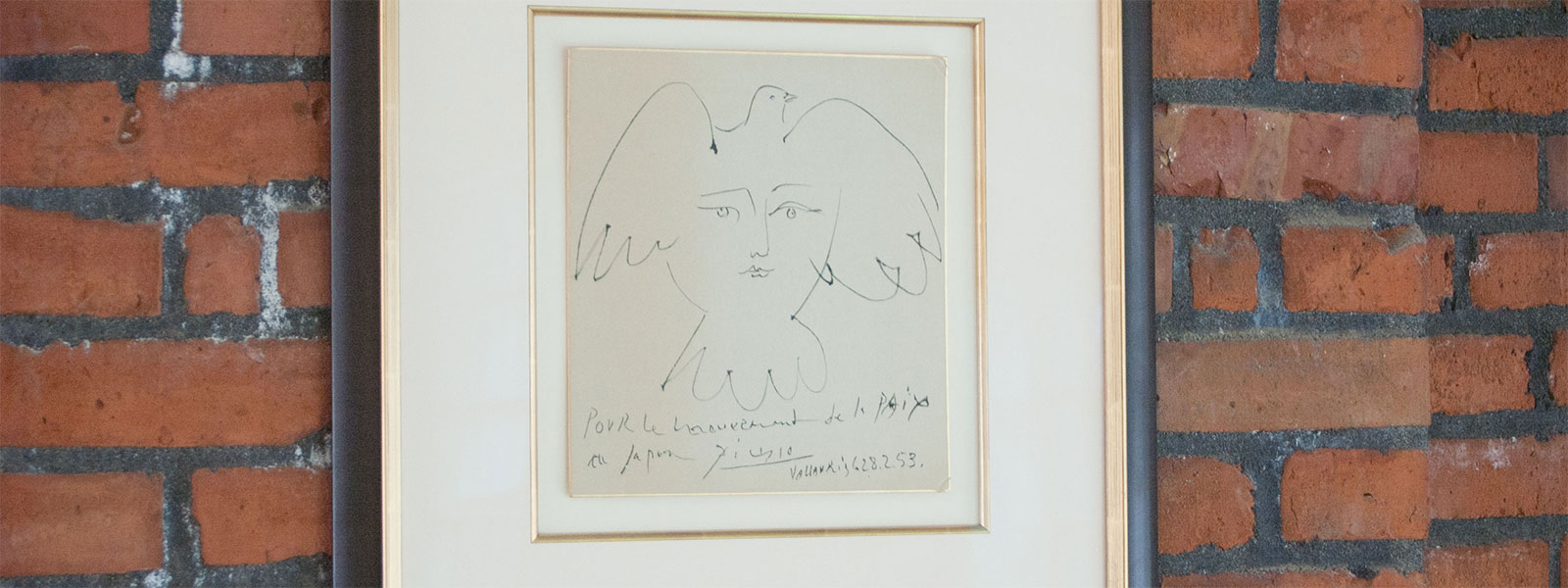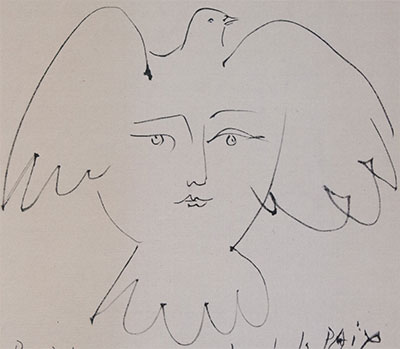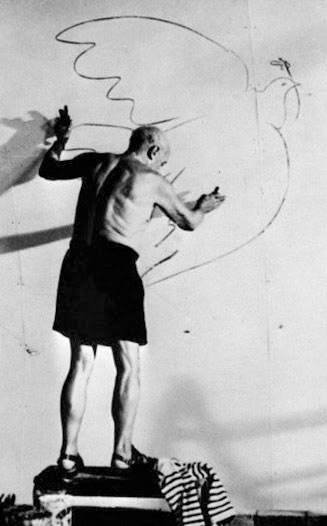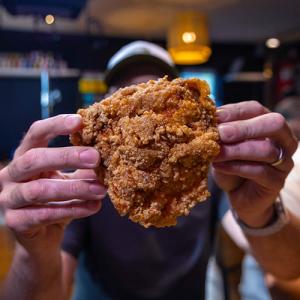
Art on Campus: Picasso's "Le Visage de la Paix"
A Picasso drawing in the UW Tacoma Library has traveled from Paris to Hiroshima to Tacoma in the name of peace.

Hanging on a wall in the Reading Room of the UW Tacoma Library in the Snoqualmie building is a small Picasso drawing, done in felt pen on fabric, of a woman’s face superimposed on the breast of a dove. While simple in design, “Le Visage de la Paix”, or “The Face of Peace”, is rich in history. The work has a monetary value because of its association with Picasso, but its place in history and the stories of activism and peace it holds make it invaluable as an addition to the University of Washington Tacoma campus.
“Le Visage de la Paix” has traveled across the world in the last seven decades, and passed through the hands of many in order to reach its current destination at UW Tacoma. Starting in 1949, the Paris World Peace Conference adopted a lithograph of a dove designed by Picasso as its official symbol. Copies of the dove of peace were also widely distributed at gatherings of the French Communist Party, of which Picasso was an active member until his death. In following years, Picasso experimented with this design to create many variations of the original work, which were then given as a symbolic gesture of peace and reconciliation to nations impacted by the violence and destruction of World War II. UW Tacoma’s “Face of Peace” was presented to Japan by Picasso in 1953 in remembrance of the eighth year after an atomic bomb was dropped on Hiroshima, Japan.

In 2009, Tacoma’s Father William “Bix” Bichsel traveled to Japan along with 18 others on a ‘Journey of Repentance,’ meant to symbolize contrition for the devastation caused by the use of atomic bombs at the end of World War II. Unknowingly, Bichsel and his peers would become the temporary caretakers of “The Face of Peace” while on this journey. Upon their arrival, they were able to reach out to Japanese peace activists as well as survivors of the atomic blasts. They participated in memorials for the immense loss of life and prompted discussion about the importance of pacifist activism in the face of unrest. The group had the opportunity to meet with the Japanese Peace Committee, where they exchanged gifts as customary in formal greetings in Japanese culture. Bichsel and his companions brought humble gifts representative of their community and themselves, and in return received Picasso’s 1953 drawing.
At first the group didn’t realize what they had, as the drawing was presented in a simple folder that hadn’t protected it from years of wear. One member of the group volunteered to take care of the work, and after it was appraised decided to have it framed behind museum quality glass that could preserve the fragile fabric-and-ink drawing for the future. She quietly stored the piece in her home for years until the group decided that the image needed to be appreciated by a larger audience so that people could learn from its history. This prompted them to offer the drawing to UW Tacoma, located in an area of downtown Tacoma that had historically been a Japanese immigrant community. The donation to the State of Washington art collection was a way to commemorate both the activism of Picasso and the life of Bichsel, who made peace his life mission as an activist and religious leader. “We’re very happy to be connected with them,” said Bichsel upon giving the work to the University, “They’re on their own pursuit of justice and peace.”
Picasso once said, “Painting isn’t an aesthetic operation; it’s a form of magic designed as mediator between this strange hostile world and us.” “The Face of Peace” not only symbolizes activism in pursuing justice, but encourages peace among nations and peoples, a transformative idea, even today. Picasso’s dove serves as a call to action to promote the message of the artists and activists through whose hands it has passed. From its perch on the wall in the Snoqualmie building — visible from the second floor balcony in the Reading Room — perhaps it will serve as an inspiration to passing students who may reflect on its history in the hands of Picasso, Japan, Fr. Bichsel, and now our very own UW Tacoma.



